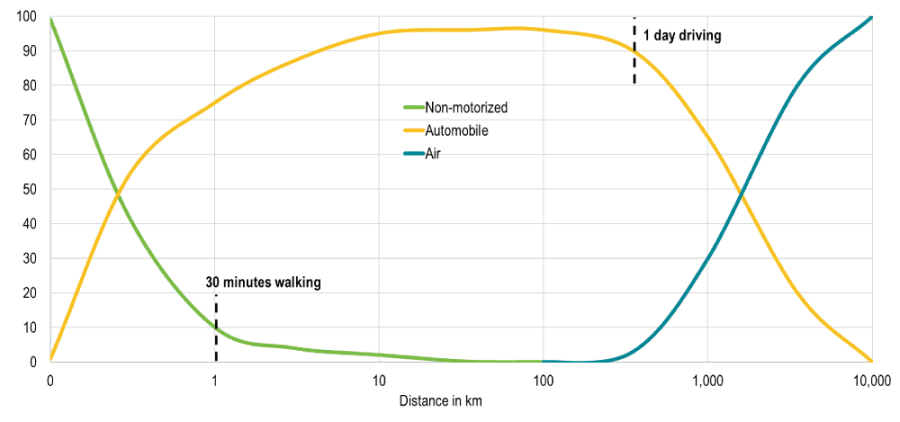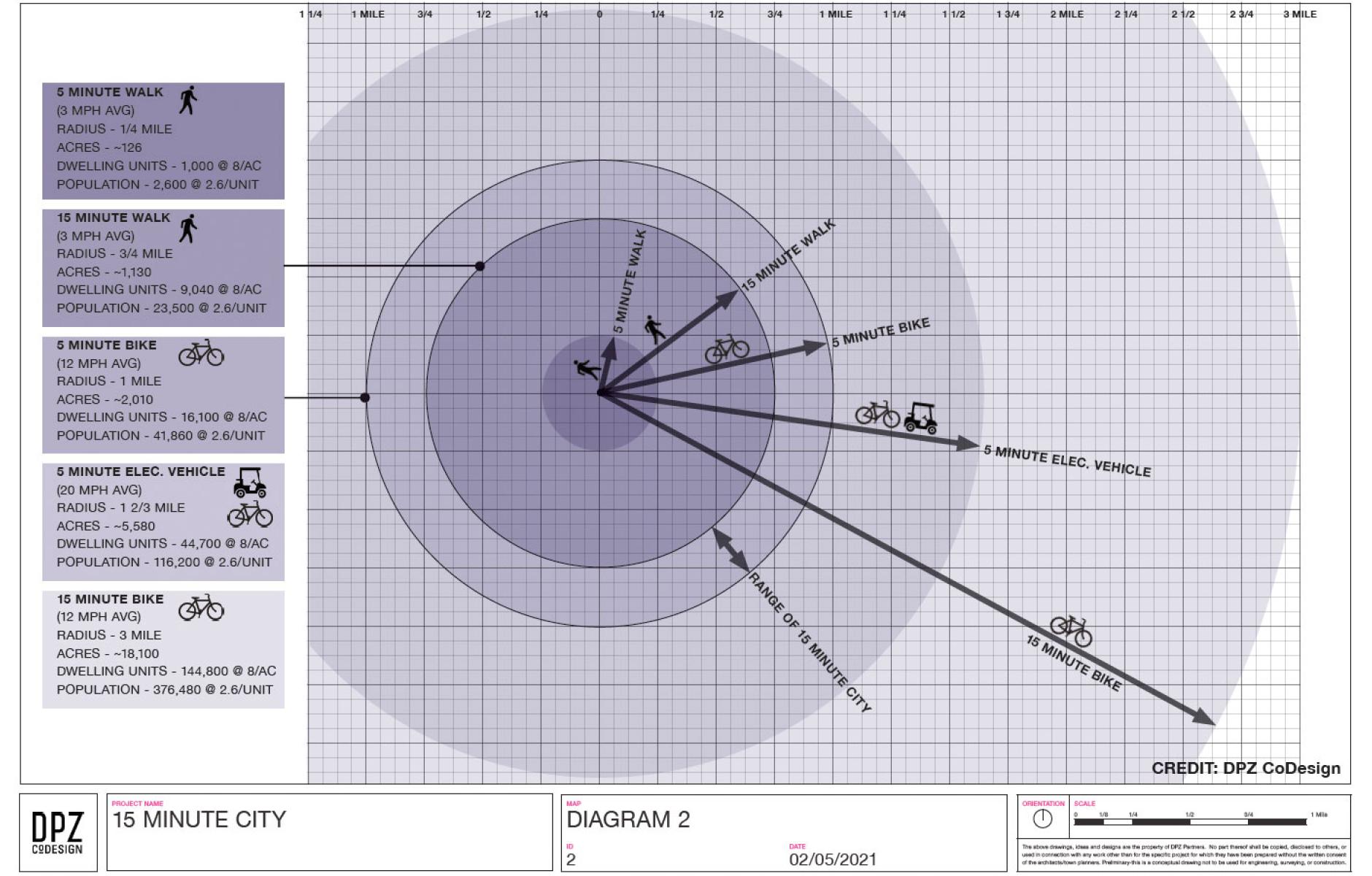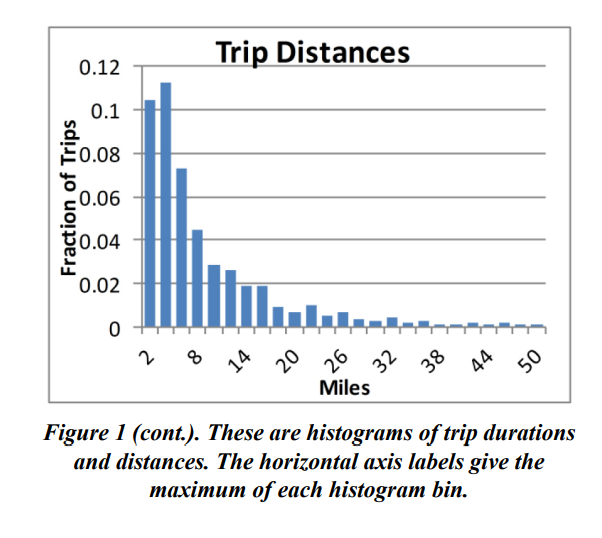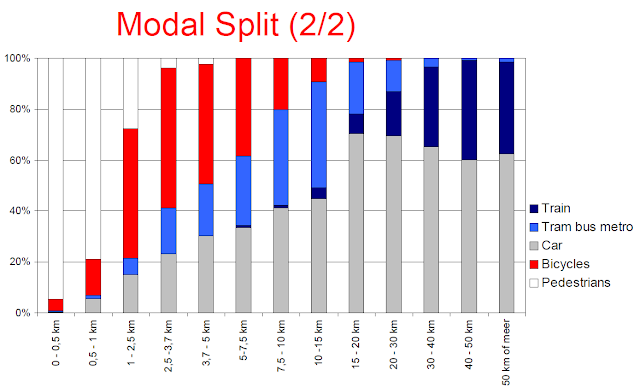Street Safety - AAA Accessibility
We've got one major problem to think about, and that is a meta-problem -- thinking about how we think about transportation networks.
Ideally, most desired trips will have options for travel mode and for specific destinations. This gets back to the "jobs to be done" way of thinking: we don't really want to drive to Homeland to buy some random item; we want to have Salisbury Steak for dinner and we're short onions and tomatoes. Ideally, we'd have some options for what store to visit, how we can get there, and when will make the trip.
For each trip, we mentally juggle available options and pick one option we prefer. Below is a basic diagram that shows how might make a transit mode decision for a trip, based on distance involved:
Clearly, the choice for short trips assumes that non-car options are available for short trips, and this is the key support behind the notion of 15-min neighborhood. As we noted in the Street Safety discussions, even short trips which SHOULD be walked or biked will actually be driven if the perceptions of a safe, pleasant, comfortable, direct trip are not in place. Unfortunately, it is often the case that short trips are not safe, but it's not the biggest problem: the bigger issue is lack of useful destinations with a walkable range. What can we do to resolve this?
- Shift our thinking from the 1950's car-first, zoning-heavy mobility strategy to a car-last accessibility strategy.
Ideally, most desired trips will have options for travel mode and for specific destinations. This gets back to the "jobs to be done" way of thinking: we don't really want to drive to Homeland to buy some random item; we want to have Salisbury Steak for dinner and we're short onions and tomatoes. Ideally, we'd have some options for what store to visit, how we can get there, and when will make the trip.
For each trip, we mentally juggle available options and pick one option we prefer. Below is a basic diagram that shows how might make a transit mode decision for a trip, based on distance involved:

Clearly, the choice for short trips assumes that non-car options are available for short trips, and this is the key support behind the notion of 15-min neighborhood. As we noted in the Street Safety discussions, even short trips which SHOULD be walked or biked will actually be driven if the perceptions of a safe, pleasant, comfortable, direct trip are not in place. Unfortunately, it is often the case that short trips are not safe, but it's not the biggest problem: the bigger issue is lack of useful destinations with a walkable range. What can we do to resolve this?
- Get people on bikes to increase the useful. This means prioritizating safety for cyclists, and doing enough of the traffic-calming things from the last post to make people feel and actually be safe biking on residential streets and at least crossing arterials. Here is why: an easy 5-minute neighborhood is traditionally about 1/4mi radius in size, and this is pretty easy for older people, children, and parents with strollers to manage. You could fit four of these in my standard suburban section; however, each would have only 1,000 people, which means I might, maybe, have one or two businesses conveniently located IF they were allowed by zoning.
Our more recent definition is a "15 minute neighborhood", which makes it more like 3/4 mile, and depending on where you are in my section that would mean you could cover most or all of it. This gets you 4-5K people, and access to several commercial corners, but this still isn't enough people to support much variety of businesses. It's also too for infirm people to confidently go routinely, and it's a significant time investment. Instead of 5 minutes each way and 15 minutes shopping, for 60% efficiency, it'll be 30 minutes travel for 15 minutes of shopping for 33% efficiency. Most people would rather drive.
Now consider bikes, and especially e-bikes and scooters. A 5-minute bike ride will cover more area than a 15-min walk, and an e-bike further still, and with less effort. Now the full section is easily available, and with one arterial crossing so are 8 more, or at least parts of them. 9 sections of suburbia here by my house is 30K people, and for the city overall about 20K (including the less-developed edges). For common amenities like restaurants, dentists, pharmacies, convenience stores, parks, and schools, at least a few will be available, and perhaps a grocery and a clothing store or two.
Of course a 15-minute ride is readily "possible" for a reasonably motivated cyclist, which would include any teen wanting to get to their practice or friend's house, but maybe not every person just wanting to grab a coffee or meet up for lunch. And that's OK -- those who currently are without good options will have good ones, and those with options will have new ones that are healthier and more rewarding. - Shift zoning to better support infill development and close-in retail businesses. Nobody wants a smelter next to the elementary school, and zoning makes sense to a degree. Nobody will much care if there is bakery or coffee shop on the way too or from the school as long as it doesn't attract traffic. That needs to be the goal: enable small businesses that serve locals but cannot attract drivers. Add some taxation of land (apart from the buildings) and eliminate parking minimums, and small businesses can compete against the big-box mall at the edge of town.

- Worry more about modal share of trips than mode share of VMT. Here is why: for most people, trips commonly begin and end from home, and short trips tend to be far more numerous than long trips, and are also less likely to anchor multi-stop-trips. If you're heading across town to get a big bag of dog food from your favorite pet store, you might get milk and eggs on the way home, but if you're hungry for an omelet you're probably not going to add a cross-town errand to your dairy trip.
Since these trips mostly start and end from your house, these short trips represent the bulk of traffic near your house. Your local street will tend to have most traffic from local residents making frequent local trips, especially outside of commuter rush-hours. More than half of these fall within the easy 3-mile e-bike range even before we make any changes to zoning and incentives, and so it would not be hard to greatly reduce the traffic in our neighborhoods, along with the associated hazard, noise, and pollution.

- We see from this graphic that transit provides a solid option for the elderly or infirm who may not wish to tackle a 3 mile ride, even by e-bike. While a young woman might happily walk or bike to a local gym, and a man might bike to a coffee shop before heading to work, some will be unwilling or unable, and they too should have options. For those with plenty of options, we'll add one more. For those without good options, we should ensure transit works well, and always the goal should be for frequency over areal coverage, so the service is attractive to all.
- Over time, more neighborhoods should be come denser, with more, smaller, closer amenities. Market forces will drive these, if the incentives properly align, just as the forces of zoning, car subsidy taxation, and highway-style roads favor big-box malls by the highways and sprawling SFU neighborhoods.
- Implement SLOW speed limits for neighborhoods -- like 10mph. For a square-mile grid, 75% of homes are within about 1/4mi of an arterial, and all tend to be within 1/4mi of a collector. At 10mph, 1/4mi is only 90 seconds, which is a small fraction of any trip...and the average house will be only half that.
- Add raised crossings at every block, and mid-block for long-blocks, to help calm traffic. Today we have speed-bumps here and there. Why not make them useful, and add natural attention-focus and visibility for those crossing?
- Keep the stop-signs, for the same calming reasons, but enable Idaho Stop for cyclists.
We should make it harder for parents to drop school children off at school by car, and easy for children to walk or bike (with or without a parent). Today, cars create a self-reinforcing cycle of car-centric drop-offs by generating hazards for pedestrians and cyclists while taking the most convenient drop locations; instead, cycle parking and drop-offs should be up close, and car drop-offs should be far enough away and sufficiently isolated to not add risk to children. Once again, a modal filter could make sense, such that access to a school from an arterial can only be from one direction, with other local residents having to use the arterials to round the block to get to a car-centric drop-off point at one corner of the school property, being still and easy walk for even young children but barely impact the circumferential collector for walking/biking students.
In the end, the goal will be for it to be a little harder to drive, much safer to walk or bike or wheelchair or scoot or whatever, and with more accessible amenities growing over time for the mutual advantage of all. With a bit of work, we can make suburbia go from "Car Only" to "Car Equal" relatively quickly, and eventually be more supporting of "Car Free".
Comments
Post a Comment